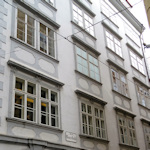
Mozart spent a lot of time abroad, gathering experiences, inspiration, and a rather fine collection of saucy postcards (I might have made that last bit up).
An exhibition in Vienna highlights how these travels might have influenced his music.
- One-room exhibition at Vienna’s Mozarthaus covering Mozart’s extensive European trips
- Features paintings, etchings, sheet music and other documents
- All display text in German and English
- Runs Feb 13, 2019 to Jan 26, 2020
- See also:
- Mozarthaus visitor & ticket info
- Current exhibitions in Vienna
- Mozart in Vienna
Mozart on his travels
“Mozart: Reisender in Europa” (to give it its official title) is an exhibition by the Archive of the Gesellschaft der Musikfreunde in Wien in Vienna’s Mozarthaus.
What you get is not a simple set of maps with “Mozart was here” scrawled on them. Instead, the exhibition presents highlights of his trips using pictures and other items, allowing you to better understand how his experiences might have impacted the composer’s personal development and music.
These displays draw on the archive’s vast stores of sheet music, letters, manuscripts, books, documents, artwork, and memorabilia collected across over 200 years of music history. It’s the third cooperation of this kind between the Mozarthaus and the Archive.
Mozart’s travels certainly cover an impressive list of destinations: London, Paris, Brussels, Prague, Berlin, Amsterdam, Geneva, Rome and Milan, to name but a few.
You can imagine how such itineraries, spread over trips lasting months and even years, would broaden your personal and musical horizons.
The early journeys, when Mozart was little more than a toddler, had multiple motivations. His father, Leopold, believed the unprecedented talents of Mozart and his sister, Nannerl, should be shared with the world, for example.
Travel also offered an opportunity to gain attention. What today we might call brand building. Extended stays in different cultures served educational purposes, too, and Mozart’s immersion in a broader aristocratic society would help him gain confidence in social situations.
Perhaps most importantly from our point of view, exposure to different musical traditions, tastes, techniques, musicians, and composers influenced Mozart’s unique artistic talents.
The sights, sounds, and conversations allowed him to take the fullness of European music and create something unique and remarkable in his own compositions.
After moving permanently to Vienna in 1781, aged 25, Mozart travelled less, not least because of family commitments (and also because the musical world tended to come to Vienna).
The few trips he took became more about income generation or promotion, for example attending the premiere of Don Giovanni in Prague.
The Mozart exhibition implicitly reveals all these concepts in a series of displays covering particular destinations.
For example:
- Commissions for the cello-playing King of Prussia following a performance in Berlin forced Mozart to rethink his approach to string quartets
- A newspaper cutting from London highlights Mozart’s early exposure to fame. The text excitedly advertises a pending concert by the eight-year-old talent. (So much was this excitement, they even got his actual age wrong – he was billed as aged seven.)
- A 1789 trip to Leipzig included visiting with a student of Bach. The influence of Bach’s compositions is evident in Mozart’s work
- Composing Mitridate, re di Ponto for the Milan opera while in Italy aged just 14 emphasises Mozart’s reputation as a musical prodigy
The exhibits also come with a sprinkling of interesting little anecdotes. For example, how Mozart popped into a performance of The Abduction from the Seraglio at the Berlin Opera House, where he proceeded to give the players performance tips.
And modern-day musicians are not the first to go on tour to correct a few financial indiscretions. We learn that all the revenue from Mozart’s 1789 visit to Berlin, Leipzig and Dresden went straight to Prince Lichnowsky to cover gambling debts.
Perhaps Mozart truly was the world’s first rock star.
Dates, tickets & tips
The exhibition opened on February 13, 2019 and runs until January 26th, 2020 (Beethoven’s year!).
You don’t need a special ticket to access the Mozart exhibition, just the normal entrance ticket for the Mozarthaus or a Vienna Pass sightseeing pass (see my review).
How to get to the exhibition
The Mozarthaus is about as central as it comes. If you listen carefully at a window, you can practically hear them reading mass at Stephansdom cathedral.
See the main Mozarthaus article for tips on how to reach the exhibition. Don’t forget to enjoy the wider museum, either. And for more places to visit on a musical pilgrimage, check this guide to Mozart locations in Vienna.
Address: Domgasse 5, 1010 Vienna